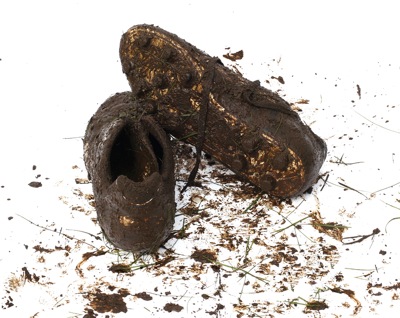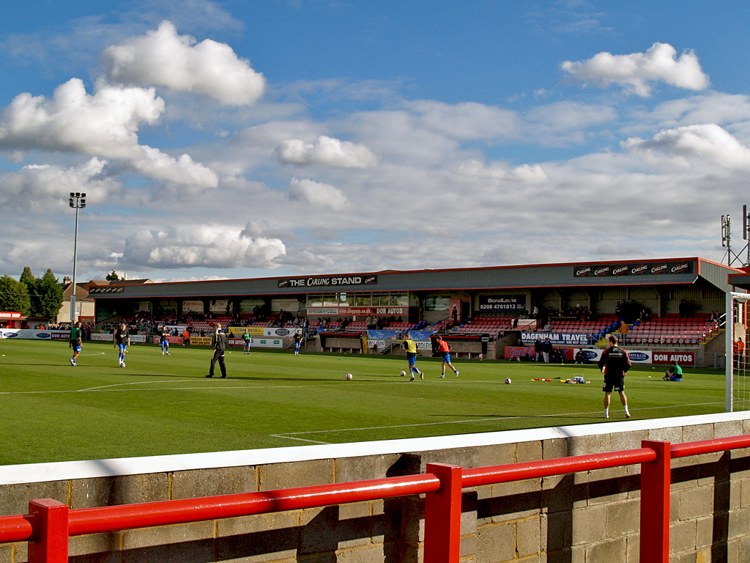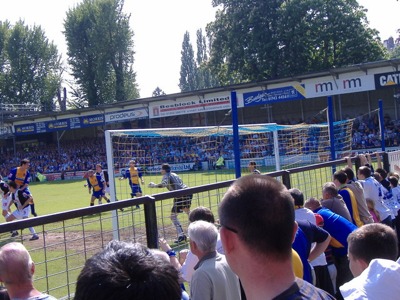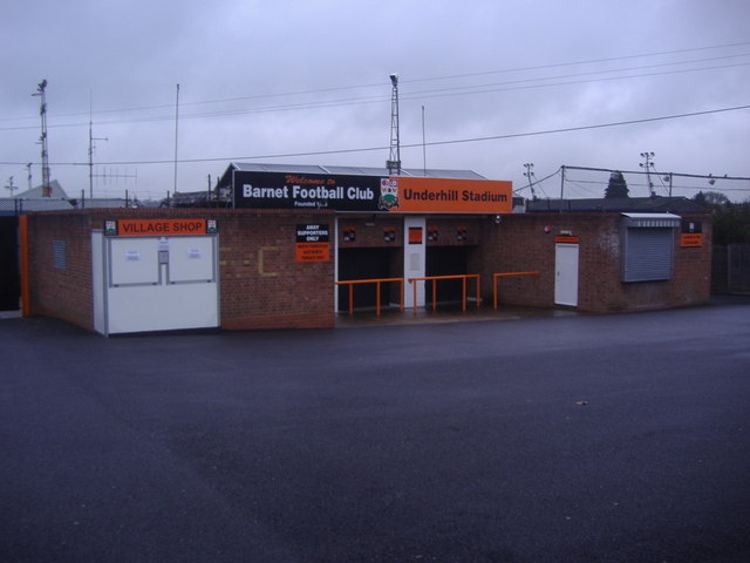National League Stadiums & Stats

Until 2015 the National League was known as the Football Conference, but a rebranding has seen it take on its current name. Sponsorship means it’s currently known as the Motorama National League and it is the fifth league in the English football system and the top league outside of the football league itself.
If you are confused, then think of English football in terms of higher and lower leagues. The first four – the Premier League, Championship, Division One, Division Two – are the higher leagues, so when you hear people talking about ‘The 92’ they’re not referring to any teams currently in the National League.
Here we’ll tell you a bit of information about the sort of stadiums you can expect to find in the National League as well as some info about the league itself and, of course, its history.
Stadium Stats
| Stadium | Year Opened | Capacity | Ave Attendance | Record Attendance | Record Attendance Match |
|---|---|---|---|---|---|
|
Aggborough Stadium
Kidderminster Harriers |
1884 | 6444 | 1802 | 9155 | Kidderminster v Hereford (27/11/1948) |
|
Boundary Park
Oldham Athletic |
1896 | 13513 | 3466 | 47671 | Oldham v Sheffield Wed (1930) |
|
Court Place Farm
Oxford City FC |
1992 | 3100 | 906 | 3099 | Oxford City v St Albans City (14/05/2023) |
|
Damson Park
Solihull Moors |
1998 | 5500 | 1517 | 4020 | Solihull Moors v Chesterfield |
|
Gateshead International Stadium
Gateshead FC |
1955 | 11799 | 1218 | 8144 | Gateshead v Grimsby Town (04/05/2014) |
|
Grosvenor Vale
Wealdstone FC |
1943 | 4069 | 1509 | 3012 | Wealdstone v Barnet (25/05/2023) |
|
Hayes Lane
Bromley FC |
1937 | 5000 | 1962 | 10798 | Bromley v Nigeria XI |
|
J Davidson Stadium
Altrincham FC |
1904 | 7873 | 2638 | 10274 | Altrincham Boys vs Sunderland Boys (28th February 1925) |
|
Kingfield Stadium
Woking FC |
1921 | 6036 | 2734 | 7020 | Woking v Finchley |
|
Meadow Park
Borehamwood |
1963 | 4500 | 1185 | 4101 | Boreham Wood v St Albans City (6th December 2021) |
|
Meadowbank
Dorking Wanderers FC |
1953 | 3000 | 1962 | 3732 | Dorking Wanderers vs Woking, 7th April 2023 |
|
Mill Farm
AFC Fylde |
2016 | 6000 | 1467 | 3858 | AFC Fylde v Chorley, 26th December 2016 |
|
Proact Stadium
Chesterfield |
2010 | 10504 | 5166 | 10089 | Chesterfield v Rotherham (2011) |
|
Recreation Ground
Aldershot Town |
1926 | 7100 | 2282 | 19138 | Aldershot v Carlisle United (28/01/1970) |
|
Roots Hall
Southend United |
1955 | 12392 | 6932 | 31033 | Southend v Liverpool (1979) |
|
Silverlake
Eastleigh FC |
1957 | 5192 | 1887 | 5025 | Eastleigh v Bolton Wanderers (9/12/2016) |
|
Spotland Stadium
Rochdale |
1920 | 10000 | 3632 | 24231 | Rochdale v Notts County (1949) |
|
Stonebridge Road
Ebbsfleet United FC |
1905 | 4769 | 1247 | 12032 | Gravesend & Northfleet v Sunderland |
|
The Hive Stadium
Barnet |
2013 | 6500 | 2056 | 5233 | Barnet v Gateshead (2015) |
|
The Shay
FC Halifax Town |
1921 | 10401 | 2192 | 36885 | Halifax Town v Tottenham Hotspur (14/02/1953) |
|
Victoria Park
Hartlepool United |
1886 | 7864 | 3125 | 17264 | Hartlepool v Man United (1957) |
|
Victoria Road
Dagenham & Redbridge |
1917 | 6078 | 1342 | 7200 | Dagenham v Reading (1967) |
|
York Community Stadium
York City |
2021 | 8500 | 2789 | 8209 | Leeds United v Monaco 2023 |
|
York Road
Maidenhead United |
1871 | 4500 | 1741 | 8277 | Slough Town v Wycombe Wanderers (7/04/1947) |
Team Stats
| Team | Year Founded | Nickname | Team Owner |
|---|---|---|---|
| AFC Fylde | 1988 | The Coasters | David Haythornthwaite |
| Aldershot Town | 1992 | The Shots | Shahid Azeem |
| Altrincham FC | 1891 | The Robins, Alty | Bill Waterson, Lawrence Looney |
| Barnet | 1888 | The Bees | Tony Kleanthous |
| Borehamwood FC | 1948 | The Wood | Danny Hunter |
| Bromley FC | 1892 | The Ravens, The Lillywhites | Robin Stanton-Gleaves |
| Chesterfield | 1867 | The Spireites | Chesterfield Football Club Community Trust |
| Dagenham & Redbridge | 1992 | Daggers | Trinity Sports Holdings |
| Dorking Wanderers | 1999 | Wanderers | Marc White |
| Eastleigh FC | 1946 | The Spitfires | Stewart Donald |
| Ebbsfleet United | 1946 | The Fleet | KEH Sports Ltd |
| FC Halifax Town | 1911 | The Shaymen | David Bosomworth (Chairman) |
| Gateshead FC | 1977 | The Tynesiders, The Heed | Neil Pinkerton (Chairman) |
| Gloucester City | 1883 | The Tigers | Eamonn McGurk |
| Hartlepool United | 1908 | Pools, Monkey Hangers | Raj Singh |
| Kidderminster Harriers | 1886 | Kiddy, Harriers, Carpetmen, The Reds | Richard Lane |
| Maidenhead United | 1870 | The Magpies | Peter Griffin |
| Oldham Athletic | 1895 | The Latics | Abdallah Lemsagam |
| Oxford City FC | 1882 | The Hoops | Brian Cox |
| Rochdale | 1907 | The Dale | A.S.A Kilpatrick |
| Solihull Moors | 2007 | The Moors | Darryl Eales and Calvin Barnett |
| Southend United | 1906 | The Shrimpers, The Seasiders, The Blues | Ron Martin |
| Wealdstone FC | 1899 | The Stones, The Royals | Rory Fitzgerald |
| Woking FC | 1887 | The Cardinals, The Cards | Supporter's Trust |
| York City | 1922 | The Minstermen | JM Packaging & York City Supporters' Society |
Ticket Prices
| Stadium | Season Ticket Price (Adult) | Season Ticket Price (Conc) | Season Ticket Price (Junior) | Match Ticket Price (Adult) | Match Ticket Price (Conc) |
|---|---|---|---|---|---|
| AFC Fylde | £190 - £475 | £190 - £475 | £0 - £120 | £8 - £35 | £8 - £35 |
| Aldershot Town | £299 - £320 | £262 - £299 | £98 - £105 | £22 - £22 | £18 - £18 |
| Altrincham FC | £320 - £320 | £265 - £265 | £60 - £120 | £20 - £20 | £15 - £15 |
| Barnet | £384 - £384 | £240 - £240 | £84 - £84 | £22 - £22 | £14 - £14 |
| Borehamwood FC | £230 - £230 | £0 - £0 | £50 - £160 | £20 - £22 | £18 - £20 |
| Bromley FC | £290 - £290 | £220 - £220 | £75 - £110 | £20 - £20 | £15 - £15 |
| Chesterfield | £378 - £462 | £294 - £378 | £115 - £147 | £18 - £22 | £14 - £18 |
| Dagenham & Redbridge | £335 - £390 | £230 - £270 | £100 - £110 | £15 - £21 | £10 - £15 |
| Dorking Wanderers | £260 - £340 | £210 - £250 | £20 - £250 | £18 - £18 | £16 - £16 |
| Eastleigh FC | £259 - £383 | £195 - £305 | £32 - £170 | £18 - £22.50 | £12.50 - £17.50 |
| Ebbsfleet United | £295 - £330 | £235 - £270 | £35 - £145 | £19 - £19 | £15 - £15 |
| FC Halifax Town | £329 - £349 | £329 - £349 | £0 - £89 | £21 - £21 | £18 - £18 |
| Gateshead FC | £325 - £325 | £220 - £220 | £90 - £145 | £20 - £20 | £15 - £15 |
| Gloucester City | £200 - £200 | £105 - £105 | £7 - £7 | £12 - £12 | £6 - £6 |
| Hartlepool United | £325 - £365 | £250 - £285 | £50 - £95 | £20 - £20 | £14 - £14 |
| Kidderminster Harriers | £322 - £368 | £230 - £276 | £46 - £230 | £18 - £20 | £14 - £16 |
| Maidenhead United | £269 - £339 | £199 - £269 | £115 - £184 | £20 - £20 | £15 - £15 |
| Oldham Athletic | £230 - £230 | £140 - £140 | £40 - £40 | £18 - £22 | £8 - £10 |
| Oxford City FC | £295 - £295 | £210 - £210 | £105 - £105 | £13 - £18 | £12 - £17 |
| Rochdale | £175 - £310 | £150 - £260 | £25 - £85 | £18 - £22 | £10 - £14 |
| Solihull Moors | £299.25 - £299.25 | £199.50 - £199.50 | £103.95 - £103.95 | £17 - £21 | £12 - £16 |
| Southend United | £295 - £295 | £185 - £185 | £65 - £110 | £18 - £20 | £13 - £15 |
| Wealdstone FC | £325 - £325 | £225 - £225 | £10 - £80 | £18 - £20 | £13 - £15 |
| Woking FC | £389 - £389 | £269 - £269 | £89 - £159 | £20 - £23 | £15 - £18 |
| York City | £299 - £299 | £250 - £250 | £45 - £105 | £20 - £20 | £15 - £15 |
National League Stadiums

In football there are rarely any absolutes. It would be really easy to assume that the stadiums used by teams in the National League are all pretty basic in appearance, but the truth is that some genuinely big clubs have been relegated down through the league system and ended up here. Consequently, the nature of the stadiums you might encounter includes these bigger, more top-tier grounds.
Of course, this is a rare occurrence. The bigger clubs with the bigger grounds tend to also have bigger support that in turn brings in more gate money. The more money clubs have to mess around with the more likely it is that they’ll be able to buy high-quality players, win more games and keep themselves in the higher leagues of the English game. They’ll also use some of that money to develop their grounds and, hey presto, they make more money and the cycle repeats.
For that reason, without being guilty of a sweeping generalisation, the grounds you’re likely to experience when you go and watch some National League games will usually be basic in nature. Most of the teams in the National League are fully professional, but not all of them. As such, they don’t have a huge amount of money to spend on their stadiums and you’ll find that a good majority of them are made up of grounds with terraced sections and limited seating. There might be a food truck or somewhere to buy a pint, but don’t expect the sort of facilities you’d find at a Premier League or Championship ground.
- Aggborough Stadium
- Boundary Park
- Court Place Farm
- Damson Park
- Gateshead International Stadium
- Grosvenor Vale
- Hayes Lane
- J Davidson Stadium
- Kingfield Stadium
- Meadow Park
- Meadowbank
- Mill Farm
- Proact Stadium
- Recreation Ground
- Roots Hall
- Silverlake
- Spotland Stadium
- Stonebridge Road
- The Hive Stadium
- The Shay
- Victoria Park
- Victoria Road
- York Community Stadium
- York Road
About The League

The National League System is the system put in place for teams that would traditionally be called ‘non-league’ sides – which is confusing, of course, because in actual fact they do play in a league. The term ‘non-league’ refers to any club that is not part of the Football League system or the Premier League. The clubs that compete in the top-flight, the Championship, League One and League Two are commonly referred to as ‘The 92’ because, somewhat obviously, there are 92 of them. If a club plays competitive football but has either never been in or has been relegated from the Football League, then they enter the ‘non-league’ system, which starts with the National League.
There are 24 clubs in the National League that compete to avoid relegation and gain promotion. If they are promoted then they enter into League Two, whilst if they are relegated then they end up in either the National League North or the National League South, depending on where in the country the team is located. Despite those being two separate leagues they are on an equal footing as Step 2 of the National League System.
There are 22 clubs in each of those two regional leagues and 24 clubs in the National League. Two teams are promoted from each of the regional leagues and four teams are relegated from the National League. Two teams are promoted to League Two, with the National League champions going up automatically and the four teams below them entering play-offs.
National League History

The National League began life in 1979 under the title of ‘The Alliance Premier Football League’. In 1986 this changed to ‘The Football Conference’ and then in 2015 it became the ‘Vanarama National League’ – though the ‘Vanarama’ bit is purely for sponsorship reasons. This sponsorship changed in 2020, although not by much, becoming the Motorama National League. The league was originally made up of the leading clubs from the Northern Premier League and Southern League, such as Bangor City, Barnet, Boston United, Worcester City, and Yeovil Town.
Since 1984 the league has most commonly been known by names associated with the companies that have sponsored it. From 1986 until 1998 this was General Motors and the name given to the league was the GM Vauxhall Conference. From 2007 until 2013 it was the Blue Square and then the Blue Square Bet league. The name you most vividly remember it by is perhaps a good reflector of your age!
Up until 2004 the National League was a single division. It changed when it became the Conference National, and the Conference North and Conference South were introduced one level down. Altrincham, Enfield, Kidderminster Harriers, Macclesfield Town, Maidstone United and Stevenage Borough have all won the National League twice, but Barnet hold the record of winning it three times.
Although no member of the National League has ever gone on to play in the Premier League, several clubs did compete in the top-flight of the English game when it was known as the Football League. These are namely Carlisle United, Oxford United, Luton Town, and plucky little Grimsby Town.
Interestingly teams were not always guaranteed promotion to the Football League simply by winning the National League. Until 1987 teams had to be ‘elected’ to the Football League by its other members. In 1987 promotion and relegation between League Two and the National League was agreed, though the club’s stadium did need to meet certain criteria in order to secure promotion. This didn’t always happen and so teams like Northampton Town, Exeter City, and Torquay United were actually able to avoid relegation as the teams due to be promoted didn’t reach the criteria. This has not been a problem since 1997.
